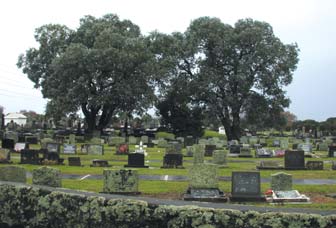PESTS AND DISEASES OF FORESTRY IN NEW ZEALAND
Skeletoniser found in Auckland cemetery
From Biosecurity Issue 30, September 2001.
The Australian insect, gum leaf skeletoniser (Uraba lugens) was found on four eucalyptus trees at the Waikaraka Cemetery in Onehunga on 9 August, during routine surveillance. Following the find, MAF initiated a delimiting survey to determine how far the pest had spread.
Caterpillars of Uraba lugens have been recorded on the following species in New Zealand:
- Eucalyptus cinerea
- Eucalyptus crenulata
- Eucalyptus leucoxylon
- Eucalyptus macarthurii
- Eucalyptus maidenii
- Eucalyptus saligna
- Eucalyptus viminalis
- Lophostemon conferta.

In Australia the gum leaf skeletoniser is known to cause periodic defoliation of some Eucalyptus species, and its close relation Lophostemon conferta. There are no known recordings of it feeding on other types of plants. A number of Eucalyptus species have been introduced in New Zealand for commercial wood and fibre production, shelter belts, amenity purposes and soil stability.
Previous find in Mount Maunganui
Gum leaf skeletoniser was first discovered at Mt Maunganui golf course in June 1997 (Biosecurity 23:14). Regular treatment within the Tauranga district have reduced pest activity. Both the Mt Maunganui and the Auckland finds were the result of the MAF Forest Biosecurity risk site surveillance programme, carried out under contract by VIGIL, Forest Health Advisory Services.
Initial find limited

Activity at Waikaraka Cemetery was confined to four mature silver dollar gums (Eucalyptus cinerea), growing within 30 metres of each other. Three egg masses were found. Limited feeding damage was reported and caterpillar numbers were low.
The infested trees and host trees within a 100 metre radius were immediately sprayed with the insecticide Decis Forte (Deltamethrin). As some of the trees are 40 metres high, a cherry picker was used to ensure that the tops of the trees were adequately treated. A drop sheet placed under the trees during spraying to collect dead insects did not reveal any further evidence of the pest.
On completion of the initial treatment, 110 identified host trees within a 1 kilometre radius of the infested area were intensively surveyed. A less intense survey of host trees up to a further 500 metres was also carried out. Trees were inspected over three days, both from cherry pickers and the ground. No further evidence of gum leaf skeletoniser was found. The area will continue to be monitored.
Mark Ross, National Adviser, Forest Pest Surveillance and Response, MAF Forest Biosecurity



